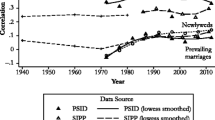Abstract
This research has two goals: to measure the extent of assortative (non-random) mating by college major in the United States, and to assess the extent to which assortative mating by college major increases earnings inequality among college-educated couples. Assortative mating of college graduates with other college graduates has been extensively studied, but research on assortative mating by field of study is rare. The analysis uses a large sample (659,732 couples) from five years of the American Community Survey public use files to group college degrees into nine categories, compute the frequency of all marital pairings, and compare these frequencies to a random assignment of pairings. The results show that assortative mating by college major is common for all majors and both genders, and that these results are robust to division of the sample by age group. Because high-earning majors tend to be married to spouses from the same high-earning major group, and likewise for low-earning majors, assortative mating increases earnings inequality among two-earner college-educated couples. The extent of this increased earnings inequality is calculated with both dollar measures and standard aggregate measures of inequality. Thus college-educated Americans tend to marry persons with similar college majors and this tendency measurably increases earnings inequality among college-educated couples.

Similar content being viewed by others
Notes
Like all surveys, the ACS is also subject to sampling error and does not generate precise estimates for the entire population. The sampling error of the PUMS is somewhat larger than in the original ACS data because the public-use sample only contains about two-thirds of the ACS results, and also because adjustments, including top-coding of income, are made to protect respondents’ anonymity. Combining five years of data reduces the effect of sampling error. IPUMS USA harmonizes the coding of variables across the five years, including adjustment of dollar values to constant dollars of the final year of the sample. Further information on the accuracy of data in this five-year dataset can be found at https://usa.ipums.org/usa/resources/codebooks/AccuracyPUMS_1216.pdf
Individual earnings by college major are described in greater detail in Carnevale et al. (2013).
Because the dataset encompasses a broad range of ages, it is useful to investigate whether the pattern of sorting persists across age cohorts (Greenwood et al. (2014) use a similar procedure). Online Supplemental Appendix Tables 1 and 2 show results from dividing the sample into couples with the higher-earning spouse over 45 years old (high age) and those with the higher-earning spouse 45 and under (low age). These sub-samples are of similar size: 360,479 high-age couples and 299,253 low-age couples. The pattern of assortative mating by college major appears to be robust to subdivision by age.
Online Supplemental Appendix Tables 3 and 4 show the pattern of earnings differences in both of the age subgroups, and Online Supplemental Appendix Figures 1 and 2 show the comparisons to the earnings with random mating in both age subgroups. Like the pattern of assortative mating, the pattern of average couples’ earnings by major pair appears to be robust to subdivision by age.
References
Altonji, J. D., Kahn, L. B., & Speer, J. D. (2014). Trends in earnings differentials across college majors and the changing task composition of jobs. The American Economic Review, 104(5), 387–393.
Bičáková A., Jurajda Š. (2017). Field-of-study homogamy. CERGE-EI working paper. http://home.cerge-ei.cz/Alena/homogamy.pdf
Carnevale A.P., Strohl J., Melton M. (2013). What it’s worth: The economic value of college majors. Georgetown University Center on Education and the Workforce. https://cew.georgetown.edu/wp-content/uploads/2014/11/whatsitworth-complete.pdf .
Eika, L., Mogstad, M., & Zafar, B. (2019). Educational Assortative mating and household income inequality. Journal of Political Economy, 127(61), 2795–2835.
Fernández, R., & Rogerson, R. (2001). Sorting and long-run inequality. Quarterly Journal of Economics, 116(4), 1305–1341.
Greenwood, J., Guner, N., Kocharkov, G., & Santos, C. (2014). Marry your like: Assortative mating and income inequality. The American Economic Review, 104(5), 348–353.
Kirkeboen, L. J., Leuven, E., & Mogstad, M. (2016). Field of study, earnings, and self-selection. Quarterly Journal of Economics, 131(3), 1057–1111.
Mansour, H., & McKinnish, T. (2018). Same-occupation spouses: Preferences or search costs? Journal of Population Economics, 31(4), 1005–1033.
Pestel N. (2017). Searching on the campus? Marriage market effects of the student gender composition. Working paper IZA DP no. 11175 http://ftp.iza.org/dp11175.pdf
Ruggles S., Genadek K., Goeken R., Grover J., Sobek M. (2017). Integrated public use microdata series: Version 7.0 [dataset]. University of Minnesota, Minneapolis. https://doi.org/10.18128/D010.V7.0, last accessed 8/19/18.
Schwartz, C. R. (2010). Earnings inequality and the changing association between spouses’ earnings. American Journal of Sociology, 115(5), 1524–1557.
Schwartz, C. R., & Mare, R. D. (2005). Trends in educational Assortative marriage from 1940 to 2003. Demography, 42(4), 621–646.
Author information
Authors and Affiliations
Corresponding author
Additional information
Publisher’s Note
Springer Nature remains neutral with regard to jurisdictional claims in published maps and institutional affiliations.
Electronic supplementary material
ESM 1
(XLSX 41.3 kb)
Rights and permissions
About this article
Cite this article
Seiver, D.A., Sullivan, D.H. A Study of Major Impact: Assortative Mating and Earnings Inequality Among U.S. College Graduates. Atl Econ J 48, 237–252 (2020). https://doi.org/10.1007/s11293-020-09667-1
Published:
Issue Date:
DOI: https://doi.org/10.1007/s11293-020-09667-1




